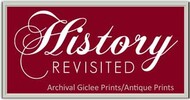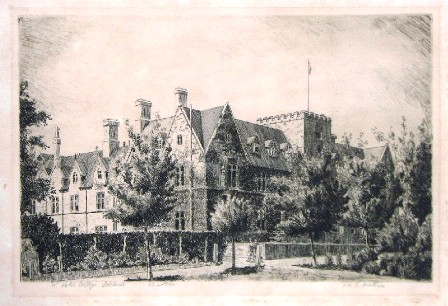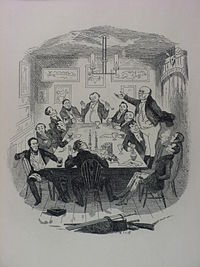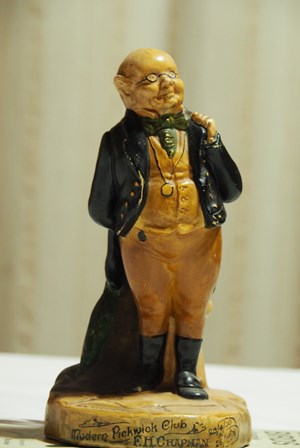 Loading... Please wait...
Loading... Please wait...All prices are in All prices are in EUR
Categories
- Home
- Blog History Revisited
- WWI Diggers
Blog History Revisited - WWI Diggers
Modern Pickwick Club, Adelaide Students, ANZAC, WWI
Posted by ©Sandra Ker Owner Antiquarian Print Gallery 1989-2018 Unley Rd., South Australia. Dealer in Antique Prints & Maps. www.historyrevisited.com.au on 28th Aug 2015
The Power of Belonging: THE MODERN PICKWICK CLUB, Adelaide
- "Pickwickians": An Ancestral Treasure of Adelaide, 1934.
-
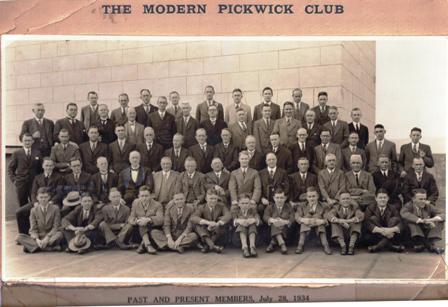
This is a lesson of "Birds of a feather stick together". A curious battered item appeared in a cache of ancestral photos. Entitled "THE MODERN PICKWICK CLUB - Past and Present Members, July 28, 1934", the faces were unsmiling, standard for the shutter-speeds of the era, but why the striped socks? It has not been the uniform of any local club, team or association that I was familiar with. Something was afoot (so to speak)! My heart jumped with joy! There was the expected mix of English and German names. German settlers had found refuge in colonial South Australia since as early as 1839. Many would have "anglicized" their names during WWI the anti-German sentiment, but curiously not here. Certainly suburbs inspired by German heritage, like Bismark, and regional towns like Hahndorf, were renamed.
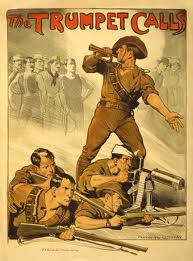
Recruitment Poster 1914-18
Was this a study of social power of familiarity that would have touched those gathered under the umbrella of common interest in the spirit of "for better or worse, for richer or poorer". During The Great War between 1914-18, to serve King and Country with your mates, impacted urban and rural communities alike. Australia offered up an Expeditionary Force of 20,000 men. There seemed no question that the colonial "slice of London in the Antipodes", now South Australia, would join the European stoush. Shopkeepers, farmers, bakers, accountants, sportsmen...and "Pickwickians", answered that call. South Australia sent over 6000 soldiers. Of those 497 are recorded as Gallipoli fatalities. Of the many names inscribed on War Memorials throughout our state, eight Pickwickians are among their number. I, for one, will be aware of this when honoring those never to see home again on the 25th of April each year.
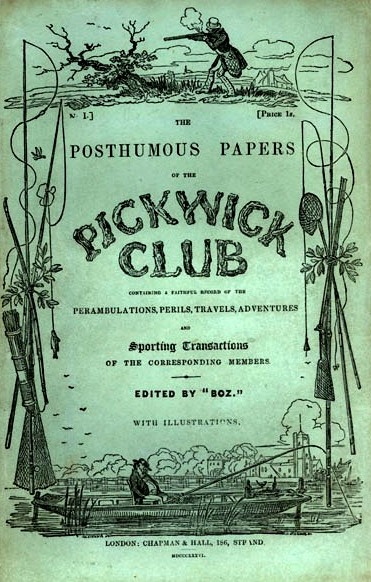
Charles Dickens Literally Enters the Lives of Generations
- "Pickwick Club" cover page, 1937
- The Posthumous papers of Mr Pickwick was the first literary challenge of Mr. Charles Dickens. Published by monthly subscription during 1836-37, Messrs Chapman & Hall had set a challenge to depict a club riddled with the sporting misadventures of its gentlemen members. Turns out their inspiration came from the ranks of wealth a-massing merchants. The inhabitants of these pages became the new Middle Class of British society.
The publishers first signed up popular comical illustrator Robert Seymour but required a wordsmith to glue it together. Enter Charles Dickens aged 24 years. I had thought the date corresponding with South Australia's settlement was a happy coincidence (1836-37). Was this a literary snap-shot of the Old World society from which many of the settlers embarked, full of this new middle class vigour eager to emulate the upper classes in this inaugural freely settled Colony of South Australia?
Dickens became the social conscience of Victorian British Society. But little did he know that the characters he created in this tome, especially Mr Pickwick and Sam Weller, would "created a world-wide furore and Dickens's imitators were legion. Pickwick parties were held as far apart as Canada and Kangaroo Island". Scandalously it turned out that Tasmania's own Henry Dowling was the first to pirate a serialized edition of Pickwick Papers from August to December 1838. Goodness, the ink had barely dried on Dickens' original publication!
A Good "Private School" Education
St. Peter's College, Adelaide. Etched F.W.G. Mathwin, 1935
Nearly 65 years later we meet a group of young college students enjoying a restorative Sunday morning sunbath in the vicinity of Palm Place, Hackney, a stone's throw from St. Peter's College. On this day, in 1890, "a question cropped up regarding the best means of employing their leisure hours on Saturday nights...that the association be for the intellectual and social improvement of members."
Rules were that members should not exceed 30 at all times, they meet EVERY Saturday night without fail, with nights "divided between debate, music, and elocution. It was a good training ground, and the atmosphere was clean and wholesome".
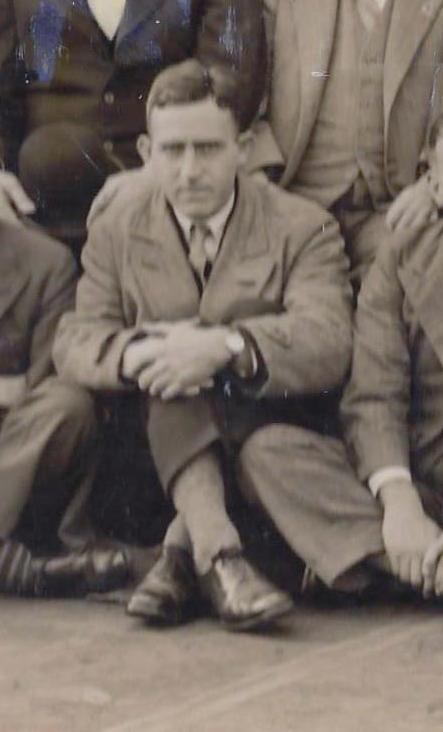 "What the Dickens?" I've found F.W.G. Mathwin, Etcher
"What the Dickens?" I've found F.W.G. Mathwin, Etcher
Having dealt in antique prints for 30 years, I had happened upon etchings of Adelaide Victorian/Edwardian public buildings and private colleges, the above "St Peter's College" is but one, signed by F.W.G. Mathwin. Here, in this curious photo, I had discovered the man himself sitting on the ground, forth from the left, cross-legged with a quizzical smirk, as a member of this Modern Pickwick Club.
To say I was tinkled pink with this unexpected discovery is an understatement.
A Big "THANK YOU" to Frank for bringing this family treasure into my gallery on Unley Road.
Typical Club Dinner with celebrated "Lamb Chops & Sauce..." and Evening Program
In the tradition of, well TRADITION, Pickwickians would begin by with a "Toast to the King" with Hock, followed by Claret, Sparkling, Sherry, Port and Muscat with respective courses. They religiously served " Chops and Tomato Sauce" with "Baked, Boiled and Mashed Potatoes" while enjoying "Resuscitated Recitations" & "Pickwickian Songs" from members who would become notable in many distinguished vocations- teachers, judges, architects, scientists, inventors, not to mention print-makers!
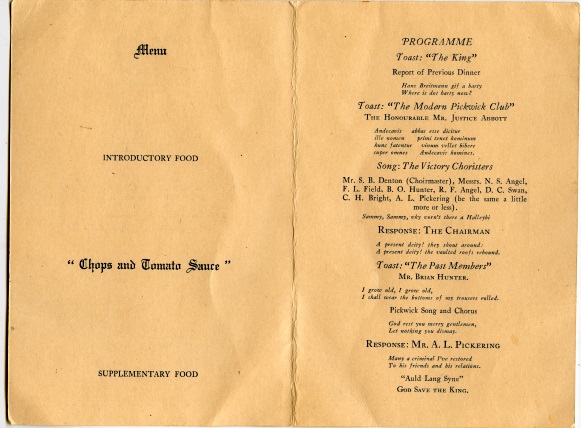
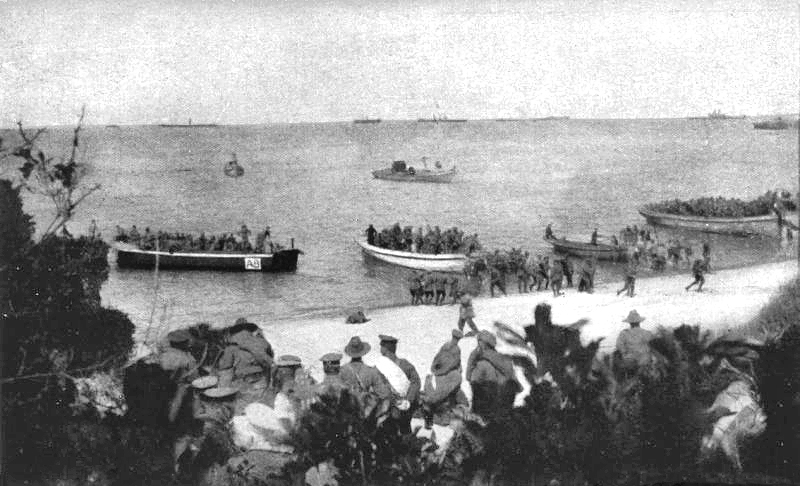
The Great War 1914-18: Fight for King and Country
The War Years 1914-18 proved a great disruption to their Rules. "During the recent big struggle 20 retired as active members to enlisted for service abroad, and of these Capt. N. C. Shierlaw and C. L. Moule, Lieuts. R. G. Raws, F. H. Lang; and A. S. Ferguson, and Ptes. A. Murton and J. Doswell made the supreme sacrifice." The meetings were reduced to once a month. The loyalty of old members happily saw them step up to cover for those war absentees. "Indeed, it seemed these original members are displaying a rotundity of form and scarcity of head covering closely resembling the appearance of Mr. Pickwick and I noticed that they attacked the principal item on the menu, 'chops and tomato sauce,' (a Pickwickian Tradition accompanied by 'Hock') with avidity." The chronicler of this occasion was an elder Pickwickian who approaches this delicate subject with good humour, as I am sure that was the supporting nature of the club.
Clubs: Value of Social Bonding
Pickwick addressing Members
After 25 years the Pickwick Club had forged a strong support system. It may well have been similar to the Mentor Programs of today. In the spirit of Charles Dickens' Pickwickians they had enjoyed lively intellectual evenings, with dancing, singing, hiking, camping, fishing and shooting with their peers. Even the retired members at the Front they were not forgotten: "During the war the soldiering members received their notification of the date of the annual gathering, and it bucked them up to see they had not been forgotten by those who were not fortunate enough to be able to join in the big adventure." As many learned during the centenary ANZAC television tributes, the postcards, letters, photographs were reminders of why ANZAC Diggers were there and may even have saved their sanity. It is generally understood that challenging times bring the very best and the very worst of humanity. If we accountable to ourselves, our family and friends, many of them we may know through senior citizen, sports and other social clubs, then just maybe we can all be contributing to the positive of that spectrum. That's what we learn by example through the actions of the Pickwickians.
 What Had This Club Achieved?
What Had This Club Achieved?
The 1990 Menu looks familiar!
I am revisiting this blog article as the first weeks of the Covid-19 global pandemic of 2020 have revealed some surprizingly selfish mass-behaviour. What happened to social cohesive groups in the past when war, recessions and illness struck their communities? It seems so far people have panic-purchased every roll of toilet paper so there is not a square to spare anywhere. I reflected on this Modern Pickwick Club as they displayed an enduring bond of fellowship among its members. Whatever toilet rolls they had I sure they would have shared. After the privilege of seeing this photograph I asked members of local Senior Citizen Club if they had heard of it. Some smiled, chuckled and began to recite occasions of this or that occasion. It reminded me of my own experience with the annual University of Adelaide "Prosh Day". I was eager to discover if the Modern Pickwick Club had managed to survive the many hurdles, of second half of the twentieth century. Evidenced to the right, I discovered a menu and program for the centennial meetup in 1990. I would be very pleased to know if this amazingly valuable Pickwick Club still exists. (Maybe the Adelaide Toastmasters Club would know?) In the spirit of "Men's Sheds", team sports and the Cactus & Succulent Society of SA, of which I am the current membership secretary, like minded people share enduring friendship that see beyond the superficial. Can anyone tell me?
Thanks to a Modern Pickwickian Grandson
Mr Pickwick, dedicated to F.H. Chapman, Frank's grandpa!
- My thanks to Frank Chapman No. 4 for bringing in this family treasured photograph for preservation. I wonder if he knew it was Messrs Chapman & Hall that were responsible for this launching of Charles Dickens' career? His grandpa, Frank H. Chapman sits second from the left in the bottom row. He was one of the 1934 Pickwickians. Frank Jr grew up with a statue of Mr Pickwick that he still has today to hand down to his own son.
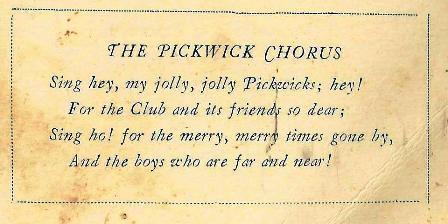
- All together now...
- "The Pickwick Chorus"
©Sandra Ker, www.historyrevisited.com.au,
Recent Posts
- » Lady Sarah Lennox, King George III & The Honourable George Napier
- » Schomburgk's Botanic Garden & Park Plan, 1874
- » "City of Adelaide" Clipper Ship - What is Old Is New Again
- » Napoleon, Hudibrastic Poetry, Doctor Syntax & the Power of Satire
- » Colonial Melbourne to Albury "Parlour Car" Photo Connects to Adelaide Past & Present
